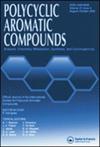Design, Synthesis, Drug-Likeness, anti-Inflammatory, Antimicrobial Activity, and Molecular Docking Studies of Pyrimidine Analogs
IF 2.6
3区 化学
Q2 CHEMISTRY, ORGANIC
引用次数: 0
Abstract
Grounded on medicinal significances of pyrimidines, herein we are reporting initially the design and synthesis of 1-(2-benzylthiopyrimidin-4-yl)-benzimidazol-2-thioacetic acid/thioacetate 2(a, b), 1-(2-benzylthiopyrimidin-4-yl)-3,5 diaryl-2-pyrazoline (3) and 1-(2-benzylthiopyrimidin-4-yl)-3,5-dimethylpyrazole (4). In silico screening such as molecular docking studies of these compounds with inflammation-causing enzyme cyclooxagenase-2 (COX-2) suggests that only 2a has shown a strong affinity for the COX-2 (−9.0 kcal/mol) and forms three hydrogen bonds with active amino acid residues in comparison with standard anti-inflammatory drugs celecoxib (-8.8 kcal/mol) and indomethacin (-7.7 kcal/mol). However, in vitro, anti-inflammatory activity reveals that IC50 of compound 2a was 3.5 μM compared to celecoxib with IC50 of 0.65 μM. Also, 2a has displayed comparable activity of standard antibacterial drug gentamycin against E. coli with MIC 6.5 μM. Furthermore, the drug-likeness of potent compounds was studied using Swiss ADME and Mol inspiration software. All the compounds showed optimum drug-likeness without violating Lipinski’s rule of five. With our best observation and based on comparative SAR studies of these analogs with celecoxib and indomethacin, we conclude that compound 2a could develop as a therapeutically potent anti-inflammatory agent.
嘧啶类似物的设计、合成、药物相似性、抗炎、抗菌活性和分子对接研究
基于嘧啶类化合物的药用价值,我们在此初步报告了1-(2-苄基噻吩基嘧啶-4-基)-苯并咪唑-2-硫代乙酸/硫代乙酸酯2(a, b)的设计与合成。
本文章由计算机程序翻译,如有差异,请以英文原文为准。
求助全文
约1分钟内获得全文
求助全文
来源期刊

Polycyclic Aromatic Compounds
化学-有机化学
CiteScore
3.70
自引率
20.80%
发文量
412
审稿时长
3 months
期刊介绍:
The purpose of Polycyclic Aromatic Compounds is to provide an international and interdisciplinary forum for all aspects of research related to polycyclic aromatic compounds (PAC). Topics range from fundamental research in chemistry (including synthetic and theoretical chemistry) and physics (including astrophysics), as well as thermodynamics, spectroscopy, analytical methods, and biology to applied studies in environmental science, biochemistry, toxicology, and industry. Polycyclic Aromatic Compounds has an outstanding Editorial Board and offers a rapid and efficient peer review process, as well as a flexible open access policy.
 求助内容:
求助内容: 应助结果提醒方式:
应助结果提醒方式:


